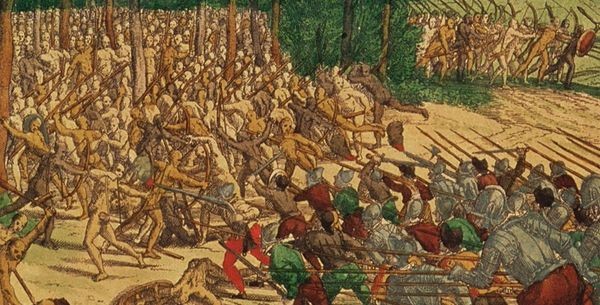Did you ever wonder how the vibrant nation of Mexico, rich in indigenous heritage, came to predominantly speak Spanish? At LEARNS.EDU.VN, we delve into the captivating story of Mexico’s linguistic evolution, exploring the historical, cultural, and political factors that led to the dominance of Spanish while also celebrating the enduring legacy of indigenous languages. Join us as we unravel this fascinating tale, offering insights into language acquisition, cultural exchange, and the ongoing efforts to preserve Mexico’s linguistic diversity. Explore the cultural nuances, language acquisition, and historical context of Spanish language adoption in Mexico.
1. Do Mexicans Speak Spanish?
Yes, Spanish is the de facto national language of Mexico, spoken by over 99% of the population. Mexico boasts the largest number of Spanish speakers worldwide. However, Mexico also recognizes 68 national languages, including over 200 linguistic variants of indigenous origin, as recognized by the National Institute of Indigenous Languages (INALI). This linguistic diversity highlights the rich cultural tapestry of Mexico.
2. What Are The Major Indigenous Languages Spoken in Mexico?
Here’s a glimpse into the ten most widely spoken indigenous languages in Mexico, illustrating the nation’s rich linguistic heritage:
| Language | Estimated Number of Speakers | Primary Regions |
|---|---|---|
| Nahuatl | Approximately 1.7 million | Central Mexico, including Veracruz, Puebla, Hidalgo, San Luis Potosí, and Guerrero |
| Yucatec Maya | Around 850,000 | Yucatán Peninsula, encompassing Yucatán, Quintana Roo, and Campeche |
| Mixtec | Over 500,000 | Oaxaca, Guerrero, and Puebla |
| Zapotec | Approximately 450,000 | Oaxaca and surrounding areas |
| Tzeltal | Around 448,000 | Chiapas |
| Tzotzil | Approximately 487,000 | Chiapas |
| Otomí | Nearly 300,000 | Central Mexico, including Querétaro, Hidalgo, and the State of Mexico |
| Mazahua | Over 150,000 | State of Mexico and Michoacán |
| Mazatec | Around 220,000 | Oaxaca and surrounding areas |
| Chol | Approximately 222,000 | Chiapas |



These languages are more than just modes of communication; they are integral to the cultural identity and heritage of the communities that speak them.
3. Why Do Mexicans Speak Spanish? Exploring Historical Context
Mexico’s historical journey as a former Spanish colony explains the widespread use of Spanish. Hernán Cortés arrived in 1519, and by 1521, the Aztec capital, Tenochtitlán, was captured. During the colonial period, lasting until 1821, Spanish authorities actively promoted their language and culture. Spanish became the language of governance, education, and religion, often overshadowing indigenous languages.
After Mexico’s independence in 1821, Spanish remained the dominant language. The government continued to promote Spanish to foster national unity and modernization. Despite the presence of indigenous languages in various communities, Spanish became the official language of communication and education.
4. Was Language Adoption Simple? Examining Complexities
Adopting the language of the colonizer isn’t always automatic. The Philippines reverted to Tagalog after independence, and India maintained its linguistic diversity. However, in Mexico, over 90% of Mexicans consider Spanish their mother tongue. This widespread adoption is a result of historical and political factors spanning over 300 years.
5. Mexico and Its Languages: Understanding a Complex Relationship
The Spanish held sway over Mexico for over 300 years, influencing the nation’s linguistic landscape. Over these centuries, the Spanish attitude towards indigenous cultures and languages evolved, creating a complex relationship.
6. How Did Local Languages and Leadership Influence Language Adoption?
When Cortés arrived, the Aztec society faced internal challenges. The Aztecs had recently conquered smaller kingdoms, each with its own language or dialect. While the Aztec nobility knew Nahuatl, most of the population spoke older languages.
7. How Did The Spanish Initially Approach Language Differences?
Initially, the Spanish leveraged the existing Aztec power structures to consolidate their own power. Unable to directly engage with numerous groups, they used the Aztec nobility as intermediaries. Spanish generals arranged marriages with Amerindian noblewomen, and schools were established to educate the children of the Amerindian nobility in Spanish law, Catholicism, Spanish, and Nahuatl. Priests and missionaries began educating peasant children in Nahuatl instead of other indigenous languages.
8. How Did A Secret Language Become A Perceived Threat?
The Spanish Crown’s attitude towards local languages shifted in the late 18th century due to tumultuous events in Europe and the Americas. In Europe, the War of the Spanish Succession emboldened Catalan and Aragonese minorities. In the Americas, indigenous rebellions in Mexico and Peru were aided by the fact that Amerindians shared a common language, Nahuatl, that most Spaniards did not understand.
In 1770, King Charles IV mandated that all official business be conducted in Spanish. The Spanish Crown began persecuting Nahuatl and Quechua speakers, labeling their languages as “savage and pagan.”
9. Did Independence Improve The Status Of Indigenous Languages?
Unfortunately, independence did not lead to a revival of indigenous languages in Mexico, unlike the resurgence of Tagalog in the Philippines. Politicians in the early Republic shared prejudices against Amerindian languages and cultures. Schools often punished children for speaking indigenous languages, and native speakers faced discrimination due to their accents. This suppression contributed to the extinction of many native languages by the late 20th century.
10. Are Indigenous Languages Still Spoken in Mexico Today?
Despite historical suppression, approximately six million Mexicans still speak one of 68 indigenous languages. Nahuatl is spoken by over a million people, while Yucatec, Maya, and Zapotec are spoken by over 100,000 people each. However, many other languages have few speakers and are at risk of disappearing.
Attitudes are changing, and the Mexican government is investing in preserving these languages by tasking linguists with recording their vocabularies. Indigenous communities are also fighting to revive their languages.
11. What Are the Key Differences Between Mexican Spanish and Spain Spanish?
Mexican Spanish and Spain Spanish, also known as Castilian Spanish, are mutually intelligible but have differences in pronunciation, vocabulary, and grammar. Here’s a table summarizing these key differences:
| Feature | Mexican Spanish | Spain Spanish (Castilian Spanish) | Example/Notes |
|---|---|---|---|
| Pronunciation | Softer ‘z’ and ‘c’ sounds like ‘s’ | ‘z’ and ‘c’ pronounced as ‘th’ | Mexico: “gracias” (gra-see-as)Spain: “gracias” (gra-thee-as) |
| Common Words | – Carro (car)- Celular (phone)- Computadora (computer)- Pluma (pen) | – Coche (car)- Móvil (phone)- Ordenador (computer)- Bolígrafo (pen) | Mexican terms often reflect American influence |
| Informal “You” | Uses “tú” almost exclusively | “Tú” and “vosotros” (plural) | Spain uses “vosotros” for informal plural “you,” while Mexico sticks to “ustedes” |
| Slang | – Órale (wow/hey)- Chido (cool)- Güey (dude) | – Vale (okay)- Guay (cool)- Tío/Tía (dude/girl) | Each country has its unique casual expressions |
| Past Tense Usage | Prefers simple past”Comí tacos” | Often uses present perfect”He comido tapas” | Mexican: “I ate”Spain: “I have eaten” |
| Indigenous Influence | Many Nahuatl words:- Chocolate- Aguacate (avocado) | Arabic influence:- Ojalá (hopefully)- Almohada (pillow) | Reflects different historical influences |
These variations highlight the diversity within the Spanish language, shaped by distinct historical, cultural, and regional influences.
12. How Can You Help Preserve Indigenous Languages in Mexico?
Connecting with a foreign culture from afar can be challenging but not impossible. Traces of indigenous culture and philosophy permeate Mexican culture.
By exploring Mexican content, such as that offered by Lingopie, you can discover Nahuatl-based slang and Aztec dishes. By understanding a country from the perspective of its inhabitants, you can appreciate it beyond stereotypes and prejudices.
Learning Spanish can also be beneficial. Lingopie offers an immersive platform for learning Mexican slang through Mexican TV series and movies with interactive subtitles. This real-life content exposes you to native slang naturally.
13. FAQs About the Spanish Language in Mexico
What language did Mexicans speak before Spanish?
Before Spanish, Mexicans spoke indigenous languages such as Nahuatl, Maya, Mixtec, and Zapotec.
What do they call Mexicans that don’t speak Spanish?
Mexicans who primarily speak indigenous languages are referred to as indigenous people or by the name of their language group.
How did Spanish come to Mexico?
Spanish was brought to Mexico by Spanish conquistadors and settlers during the Spanish colonization in the early 16th century.
Do Mexicans say they speak Spanish or Mexican?
Mexicans typically say they speak “español” (Spanish) rather than “Mexican.”
Why is Spanish still spoken in Mexico?
Spanish remains spoken in Mexico due to the lasting impact of Spanish colonization, which made it the dominant language of government, education, and culture.
Why did the Aztecs start speaking Spanish?
The Aztecs began speaking Spanish due to the Spanish colonization and conquest of Mexico, which imposed Spanish language, culture, and authority on the native populations.
14. LEARNS.EDU.VN: Your Gateway to Understanding Mexico’s Linguistic Heritage
At LEARNS.EDU.VN, we understand that learning a language is more than just memorizing vocabulary and grammar. It’s about immersing yourself in the culture, history, and people who speak it. That’s why we offer a wide range of resources to help you explore Mexico’s linguistic heritage, including:
- In-depth articles: Learn about the history, culture, and current status of indigenous languages in Mexico.
- Language learning resources: Start your journey to learn Spanish or explore indigenous languages with our comprehensive language courses and materials.
- Cultural insights: Discover the rich cultural traditions and expressions associated with different languages in Mexico.
15. Discover More with LEARNS.EDU.VN
Ready to dive deeper into the fascinating world of Mexican languages and culture? Here are some related topics you can explore on LEARNS.EDU.VN:
- The influence of Nahuatl on Mexican Spanish: Discover how indigenous languages have shaped the Spanish spoken in Mexico today.
- The fight to preserve indigenous languages: Learn about the efforts being made to revitalize and protect endangered languages in Mexico.
- Mexican literature and art: Explore the rich cultural heritage of Mexico through its literature, music, and art, often deeply connected to its diverse linguistic landscape.
By delving into these topics, you’ll gain a more profound understanding of Mexico’s linguistic tapestry and its impact on the nation’s identity.
16. Unlock Your Potential with LEARNS.EDU.VN: Call to Action
Are you ready to embark on a journey of linguistic and cultural discovery? Visit LEARNS.EDU.VN today to explore our comprehensive resources and unlock your potential to learn, grow, and connect with the world around you. Whether you’re interested in mastering Spanish, delving into the history of indigenous languages, or simply expanding your cultural horizons, LEARNS.EDU.VN is your trusted partner in education.
- Explore our courses: Browse our diverse range of language courses and find the perfect fit for your learning goals.
- Read our articles: Dive into our insightful articles and expand your knowledge on a variety of topics related to language, culture, and education.
- Join our community: Connect with fellow learners and educators to share your experiences, ask questions, and support each other on your learning journeys.
Visit LEARNS.EDU.VN today and start your adventure!
Contact Us:
- Address: 123 Education Way, Learnville, CA 90210, United States
- WhatsApp: +1 555-555-1212
- Website: LEARNS.EDU.VN
Let LEARNS.EDU.VN be your guide to a world of knowledge and understanding.
17. Summing Up Mexico’s Linguistic Journey
Mexico’s linguistic history is a complex tapestry woven with threads of colonization, cultural exchange, and resilience. While Spanish has become the dominant language, the enduring presence of indigenous languages serves as a powerful reminder of Mexico’s rich heritage.
By embracing these languages and cultures, we not only honor the past but also contribute to a more inclusive and vibrant future. So, whether you’re exploring Aztec culture, learning Nahuatl slang, or simply appreciating the beauty of the Spanish language, remember that language is a key to unlocking a deeper understanding of Mexico’s diverse and fascinating heritage.
Dive in, explore, and let language enrich your journey! Explore the possibilities at learns.edu.vn today.
Five Search Intentions of “How Did Mexico Learn Spanish”:
- Informational: Understanding the historical process of how Spanish became the dominant language in Mexico.
- Educational: Seeking detailed explanations of the key events, policies, and cultural shifts that contributed to the adoption of Spanish.
- Cultural: Exploring the relationship between Spanish and indigenous languages in Mexico, including their interactions and current status.
- Comparative: Comparing the language situation in Mexico with other former colonies to understand why Spanish remained dominant.
- Practical: Finding resources and methods to learn Spanish, particularly Mexican Spanish, and to appreciate Mexican culture.
